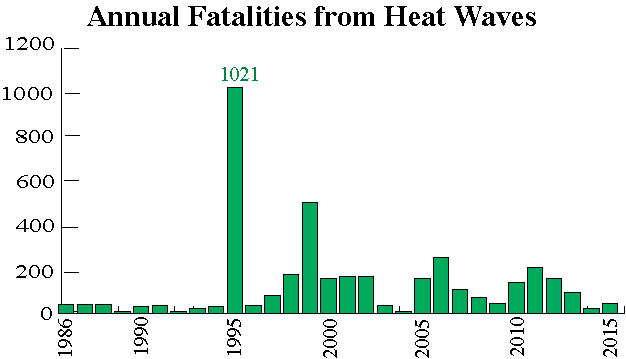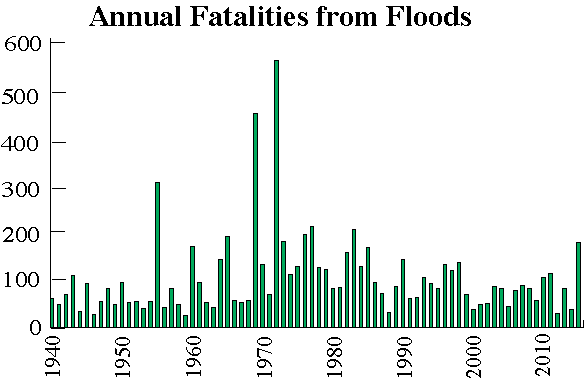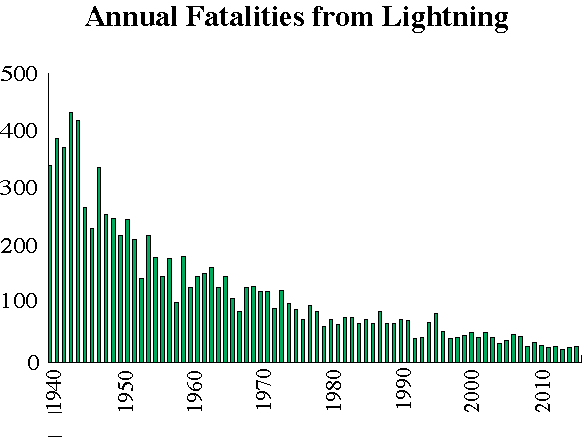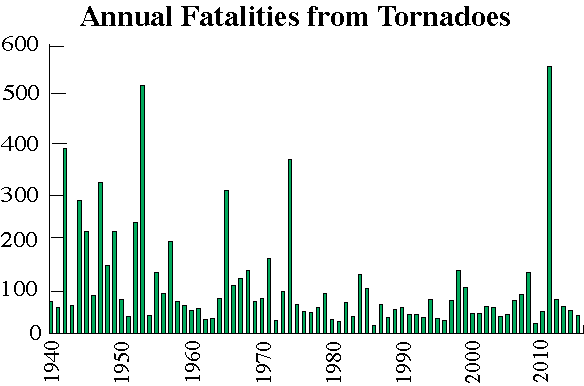What is a Natural Disaster?
- event of a natural cause with high death rate or extensive destruction
- event of a natural cause that has a negative impact on the environment
- event of a natural cause with low death rate but occurring often
- a natural trend that has negative long-term consequences
An example of a costly and devastating natural disaster was Hurricane Ike, an Atlantic hurricane in 2008 that reached well into the continent. In more recent times, in 2011, relatively weak Hurricane Irene traveled along the U.S. east coast and affected millions of people. And after 2005 Hurricane Katrina, Superstorm Sandy in 2012 has been the second-most costly natural disaster.
Not all large hurricanes make the news. An example of a truly remarkable hurricane that did not make the news (because it did not kill nor destruct human construction) was Ioke in 2006. Ioke crossed the northern Pacific Ocean in August 2006, passing Johnston Atoll and Wake Island but did not affect permanently inhabited areas. Some residents of Wake Island evacuated. It was the first category 5 and thereby the largest hurricane that ever formed in the Central Pacific Ocean. See the back end of a news clip to get info and link to satellite image.
Some Obvious Natural Disasters
- earthquakes
- volcanic eruptions
- landslides and other mass movements (e.g., mudflows, cave collapses)
- floods (flash floods but also longer-lasting floods such as from prolonged rain)
- wildfires
- severe storms (e.g., involving strong winds, heavy precipitation, lightning)
- hurricanes
- tornadoes
- impacts of space objects
Why Study Natural Disasters?
- natural disasters kill, destroy, cost (prevention, relief efforts and rebuilding)
- costs have increased exponentially over last 50 years
- the gap between losses and insured losses increases
Natural Disasters and Human Interaction
- humans can mitigate disaster risks (e.g. build EQ proof houses; build strong retaining walls)
- humans can increase disaster risks (e.g. build along EQ faults; build on foot of unstable slope)
- humans can enhance effects of natural disasters (e.g. building wrong flood control channels enhances a flood; emission of CO2 and pollutants enhances climate change)
- humans can trigger natural disasters (e.g. inappropriate drainage can trigger landslides; mining can trigger earthquakes)
The Need to Understand Natural Disasters
- need to understand process involved
- improve identification of risks
- improve prevention of losses (lives and structures)
- improve forecast and evacuations
- increase effectiveness of disaster relief (fight rising costs)
Some Not so Obvious Natural Disasters
- droughts and extreme weather (e.g., heat waves and cold snaps)
- global warming and cooling
- changing sea level
- coastal erosion
- spread of (new) diseases (e.g. SARS, Ebola)
- shift in resident species (e.g., cutting off food chain)
- solar storms (affecting power grid; rare events but of increasing concern to the developed world, especially the U.S.)
Worldwide Cumulative Fatalities due to Natural Disasters between 1947-1980(1)
| Earthquake | Tsunami | Volcanic Eruption | Flood | Hurricane | Tornado | Other Severe Weather | Mass Movement | Total | |
| # Killing Events | 180 | 7 | 18 | 333 | 210 | 119 | 147 | 45 | 1059 |
| Fatalities by area | |||||||||
| North America | 77 | 60 | 96 | 1633 | 1997 | 4568 | 5003 | 323 | 13,757 |
| Caribbean and Central America | 30,613 | - | 151 | 2575 | 16,541 | 26 | 510 | 260 | 50,676 |
| South America | 38,837 | - | 440 | 4396 | - | - | 340 | 5262 | 49,275 |
| Europe | 7750 | - | 2000 | 11,199 | 250 | 39 | 6816 | 640 | 28,694 |
| Asia | 354,521 | 4459 | 2805 | 170,664 | 478,574 | 4308 | 34,403 | 4356 | 1,054,090 |
| Africa | 18,232 | - | - | 3891 | 864 | 548 | 5 | - | 23,540 |
| Oceania | 18 | - | 4000 | 77 | 290 | - | 117 | - | 4502 |
| Totals | 450,048 | 4519 | 9492 | 194,435 | 498,516 | 9489 | 47,194 | 10,841 | 1,224,534 |
- most frequent event: floods (333 events)
- highest number of fatalities: hurricanes (498,516 deaths) and earthquakes (450,048 deaths)
- lowest number of fatalities: tsunami (4,519)
but then the Dec 26, 2004 Sumatra earthquake tsunami killed 245,000 people, making tsunami more fatal than floods in general (194,435 deaths from 1947-1980) - area with highest death rate: Asia (1,054,090) (high population density)
- area with lowest death rate: Oceania (4,502); North America (13,757)
somewhat surprisingly, Africa has the third lowest number of fatalities from natural disasters though starvation due to droughts is not included in this comparison
The Deadliest Events between 1970-2011
| Area | Time | Event | Fatalities |
| Bangladesh | 11/14, 1970 | Tropical Cyclone1 | 300,000 |
| China | 07/28, 1976 | Tangshan Earthquake | 255,000 |
| Haiti | 01/12, 2010 | Earthquake | 222,570 |
| Indian Ocean | 12/26, 2004 | Sumatra-Andaman Earthquake | 220,000 (most from tsunami) |
| Myanmar (Burma) | 05/02, 2008 | Tropical Cyclone Nargis | 138,300 |
| Bangladesh | 04/30, 1991 | Tropical Cyclone Gorky | 138,000 |
| China | 05/12, 2008 | Sichuan Earthquake | 87,449 |
| Pakistan | 10/08, 2005 | Earthquake | 73,300 |
| Peru | 05/31, 1970 | Nevados Huascaran Earthquake and Landslide | 66,000 |
| Russia | 06/15, 2010 | Heat wave and peat fires | 55,630 |
| Iran | 06/21, 1990 | Gilan Earthquake | 40,000 |
| Europe | 06/01, 2003 | Heat wave | 35,000 |
| Iran | 12/26, 2003 | Bam Earthquake | 26,271 |
| Armenia | 12/07, 1988 | Earthquake | 25,000 |
| Iran | 09/16, 1978 | Tabas Earthquake | 25,000 |
| Colombia | 11/13, 1985 | Nevado del Ruiz Volcanic mudslide | 23,000 |
| Guatemala | 02/04, 1976 | Earthquake | 22,084 |
| India | 01/26, 2001 | Gujarat Earthquake | 19,737 |
| Japan | 03/11, 2011 | Tohoku Earthquake | 19,184 |
| Turkey | 08/17, 1999 | Izmit Earthquake | 19,118 |
- single-event hurricanes/cyclones and earthquakes are major killers
- high fatality rates in areas with high population density
- this is not necessarily a developing country (e.g. Africa is missing from this table)
- To put this into perspective of what humans can do:
WW II claimed 73 Mio lives (61 M to allies; 12 M to axis), according to Wikipedia on WW II .
By January 2008, the Iraq War had cost more than 1,000,000 lives, according to the Opinion Research Business survey.
The Most Costly Events between 1970-2012 (insured losses)
| Area | Time | Event | Cost in Billion $ | Fatalities |
| USA | 08/25 2005 | Hurricane Katrina | 74.7 | 1,836 |
| USA4 | 10/29/ 2012 | Superstorm Sandy | > 68 | 288 |
| Japan1 | 03/11 2011 | Tohoku Earthquake | 35 | 19,184 |
| Pakistan2a | 08/29 2010 | Floods | 43 (econ. impact) | ?? |
| USA | 08/23 1992 | Hurricane Andrew | 43 | 25.6 |
| USA | 09/11 2001 | terrorist attack3 | 21.2 | 2,982 |
| USA | 01/17 1994 | Northridge Earthquake | 21.2 | 61 |
| USA | 09/13 2008 | Hurricane Ike | 21.1 | 136 |
| USA | 09/02 2004 | Hurricane Ivan | 15.4 | 124 |
| USA | 10/19 2005 | Hurricane Wilma | 14.5 | 35 |
| USA2b | 08 1993 | Mississippi Flood | 12 | 48 |
| Thailand | 07/27 2011 | Monsoon Floods | 12 | 813 |
| New Zealand | 02/22 2011 | Earthquake | 12 | 181 |
| USA | 09/20 2005 | Hurricane Rita | 11.6 | 34 |
| USA | 08/11 2004 | Hurricane Charley | 9.6 | 24 |
| Japan | 09/27 1991 | Typhoon Mireille | 9.3 | 51 |
| USA | 09/15 1989 | Hurricane Hugo | 8.3 | 71 |
| Chile | 02/27 2010 | Earthquake | 8.2 | 562 |
| Europe | 01/25 1990 | Winter Storm Daria | 8.0 | 95 |
| Europe | 12/25 1999 | Winter Storm Lothar | 7.8 | 110 |
| USA | 04/22 2011 | severe storms/tornadoes | 7.3 | 354 |
| USA | 05/20 2011 | severe storms/tornadoes | 7.1 | 155 |
| Europe | 01/18 2007 | Winter Storm Kyrill | 6.6 | 54 |
2anot listed at Swiss Re. Total economic impact.
2bnot listed at Swiss Re. Majority not insured.
3this is not a natural disaster but puts things into perspective, regarding costs and well as fatalities..
4from wikipedia 26 Sep 2013. This table is compiled from data provided by Swiss Reinsurance Company, and more recent data. Things that we learn from this table:
- until 2010, the 10 costliest events occurred in the U.S., one of them man-made
- 5 of these 10 events occurred within only 15 months (Aug 04 - Oct 05); the year 2006 was relatively "quiet"
- most of the costliest disasters were hurricanes though major flood events were also very costly
- Again, to put this into perspective, as of 2010, the war in Iraq has cost over $ 3 Trillion (3000 Billion or 3 Million Million).
NB: The most costly natural disaster in S.D. county was probably the 26 October 2003 Cedar Fire Paradise. It was started by a lost hunter who ignited a signal fire. The Cedar Fire, together with the Paradise and Otay fires that burned on the same weekend was the second largest wildfire in the history of CA (after the Great Fire of 1889). These three fires burned 350,000 acres, claimed 15 lives and destroyed 3500 buildings worth $1.2 billion; these fires were closely followed in significance by the Witch Creek, Rice and Poomacha fires in 2007.
Average Annual Death Rates Due to Severe Weather in the U.S.1
| Type | (1940-2015) | (1986-2015) | (1996-2015) | (2006-2015) |
| 76 yr ave | 30 yr ave | 20 yr ave | 10 yr ave | |
| Lightning | 123 | 48 | 38 | 31 |
| Flood | 102 | 82 | 82 | 84 |
| Tornado | 100 | 70 | 84 | 110 |
| Hurricane | 44 | 46 | 62 | 4.3 (!) |
| Heat waves | - | 130 | 131 | 113 |
| Cold snaps | - | 30* | 28 | 32 |
| Winter Storm | - | 40 | 36 | 26 |
| Wind | - | - | 53 | 56 |
| Rip currents | - | - | - | 53 |
1This table shows long- and short-term averages.
The numbers are compiled using Hazstats data from the National Weather Service (NWS). Note that the #1 killer depends on the time span over which data are available, i.e. lightning has been the long-term top killer (72 yr average), but the recent short-term killer is heat (20 yr average). This is because of a change in the long-term behavior in lighting deaths, see below.
Billion-Dollar Losses in the U.S. (1980-2003)
- Heat waves/droughts: 144
- Hurricanes: 102 (before Katrina)
- Floods: 55
- Cold-weather storms: 28
- Wildfires: 13
- Tornadoes: 7
Lightning, Heat Waves, Tornadoes and Statistics - Things that we learn from all this
- in the long term, lightning has been the #1 killer in the U.S. but the fatality rate has declined exponentially
- single catastrophic events, such as Hurricane Katrina, may dominate short-term averages, causing an apparent increase in average fatality
- more people in the U.S. die from heat than from severe cold (at least 5 times more!)
- over the last 30, 20 and 10 years, heat waves have been the #1 killer
- even not counting the particularly fatal year 2011 deaths from tornadoes have increased over the last 20 years!
- not counting Hurricane Katrina as single event, on average, heat waves and droughts are the costliest natural disasters in the U.S.
Heat Waves and the Elderly
 |
In 2004, a year without heat waves the 60-90 age group accounted for 21% of the people dying from severe weather. In 2006, a year with heat waves, they accounted for 34%. Elderly people cope with heat less well than younger people. Older people, especially those living on a limited budget, also may not have air conditioning in their houses. |
 |
A particularly troubling heat wave occurred in 1995, almost exactly 10 years before Hurricane Katrina caused more than 1000 fatalities. The Chicago Heat Wave July 12-16, 1995 also cost more than 1000 lives and there are remarkable parallels to the Katrina disaster:
|
 |
Heat waves may always have been a major killer but no long-term data are available at the NWS to test this. However, typical annual numbers have increased by a factor of four since the late 1980s (from 40 to 160). One could argue that the increase in heat-related deaths is a consequence of global warming but this hypothesis is difficult to test due to the lack of earlier data. Climate also has not change uniformly over the last 100 years. In fact, the 1970s were unusually cold. We will revisit this topic in lectures 15 and 23 on global climate change. |
Severe Weather - An all too common natural disaster
For example, the weekend of September 23, 2006 brought severe weather to the Midwest (Missouri) and South (Kentucky and Arkansas), with 8 fatalities by Sept 24 (12 by Sep 25). Of these 8, 1 was killed by a tornado, 1 was traffic related in heavy rain, 1 person was killed by lightning and 5 people died by flooding. All of these 5 people died in cars while the driver tried to cross a creek or other flooded regions. Trying to cross flowing water is dangerous! This includes creeks and flash flood areas in the desert.
- The water may be deeper than expected.
- The current of even shallow water can be strong and can carry cars away.
- Once the water reaches the exhaust pipe of a car, the engine stops running and people are trapped.
Recommended Reading
- (1)"Natural Disasters" by Patrick Abbott, 7th edition, 2009.
- "Heat Wave, a social autopsy of disaster in Chicago" by Eric Klinenberg; ISBN: 978-0226443225; list price: $15. This book describes the weather conditions during the July 1995 "Chicago Heat Wave" and what factors contribute to the disasters like this one. It discusses why so many people died and provides demographical insight into this particular event. It also tries to convey what it was like during this crisis.
Five Random Review Questions (not a complete review!)
- Africa
- Europe
- Asia
- Australia
- North America
- Japan
- Europe
- China
- U.S.
- Africa
- true
- false
- earthquake
- volcanic eruption
- hurricane
- 9/11
- sea level rise as a result of global warming
- hurricanes
- floods
- earthquakes
- wildfires
- heat waves
Answers: 1c; 2d; 3b; 4d; 5e



